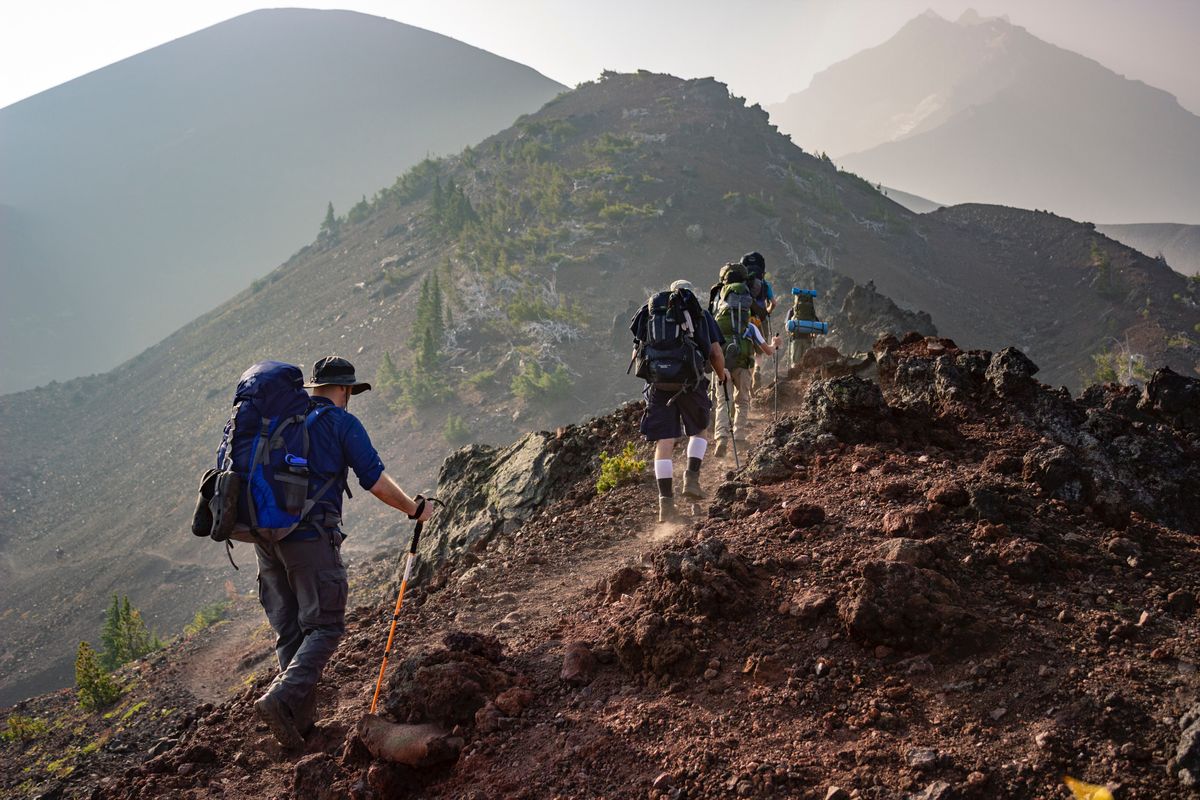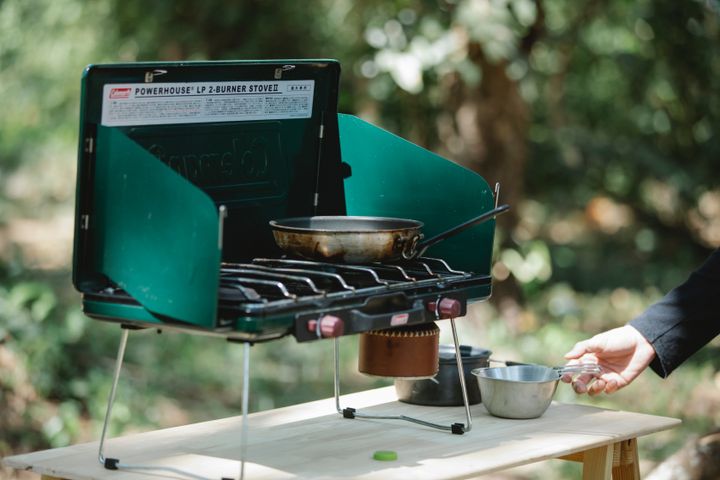Ultralight Backpacking & Essential Backpacking Gear
Are you eager to embark on an unforgettable journey backpacking through the wilderness, but not quite sure where to start when it comes to selecting the right outdoor gear?

Hey there, fellow adventurers! Are you eager to embark on an unforgettable journey backpacking through the wilderness, but not quite sure where to start when it comes to selecting the right outdoor gear?
Fear not, 'cause we've got you covered! In this comprehensive guide, we'll explore the ins and outs of the best backpacking gear to suit your needs and ensure an incredible outdoor experience. Equipped with the proper gear, you'll enjoy enhanced safety, increased comfort, improved efficiency, a lighter pack, and a more enjoyable trip overall.
So, let's get started! Continue reading to unlock the secrets to finding the perfect gear for your backpacking adventures, and soon you'll be confidently hitting the trails like a seasoned pro!
Get your free downloadable backpacking checklist here!
Backpacking - Uh, Why?
A backpacking trip into the wild has been a driving force of exploration and discovery for centuries, but in recent years, backpacking has become increasingly popular as outdoor sports is concerned. Far from just another form of travel, backpacking offers an opportunity to explore remote areas and experience nature firsthand whether a weekend warrior car camping and striking out or as thru hikers.
Stress?
Whether you’re looking to break away from the stresses of daily life or get a chance to connect with your inner explorer, there are numerous benefits to be had when it comes to backpacking. From developing camaraderie with other travelers to creating lifelong memories, this type of outdoor adventure has something for everyone.
Gear
Of course, getting started requires more than a sense of wanderlust. You’ll actually also need the right gear to make it happen. While there are tons of products on the market today that promise durability and comfort, it’s important to choose items based on weight requirements, personal preferences, and (let's be honest) our budgets. With the right balance between practicality and convenience, you can get out and hit the trail knowing that you’ve got everything you need in your very own backpacker gear.
Still Not Convinced?
After all, a backpacker is only as good as their backpack and what's in it, right? Wrong! Spending more on the gear will not increase the mental toughness required to sever ties from civilization and survive on your own. There are basic necessities of life everyone needs to have for survival based on Maslow's Hierarchy of Needs. But, it is what is at the very top of the pyramid, self-actualization or fulfillment of one's potential, that drives us into the wild. Sorry, for the detour, but, I think it is worth covering.

The Gear - Your Backpacking Setup
Ok, you're convinced to do this thing. Congrats! Before you embark on your thrilling mountain adventure, it's essential to equip yourself with the right gear to ensure a safe, comfortable, and enjoyable experience. To start, you'll need a comfortable and sturdy backpack, designed to distribute weight evenly and help you carry your essentials with ease. Proper footwear, such as supportive hiking boots or trail shoes with good traction, is also crucial to help you navigate the varied terrain you'll encounter. Weather-appropriate clothing, including moisture-wicking base layers, insulating mid-layers, and waterproof outer layers, will keep you comfortable and protected in diverse conditions. Remember, at high elevations, the weather can change without warning in a very short period of time!
But that's not all. You'll need a reliable tent and a warm, lightweight sleeping bag preferably rated 10 - 20 degrees lower than what you anticipate. And don't forget essential accessories like a map and compass to navigate your way, trekking poles for additional stability and longevity, and a first aid kit for unexpected emergencies. Speaking of emergencies, you need a way to communicate that is not dependent on a cell tower in most great backpacking locations. By thoughtfully selecting and packing the right gear, you'll be well-prepared to conquer the mountains and create unforgettable memories in the great outdoors. If it seems like a lot, well, it is. The overall goal is to take everything you need and nothing you don't since the space in that pack is relatively small.
Backpack
Backpacking packs (sounds redundant but there are lots of packs), need to match the capacity to the trip you have planned. As a general rule:
- 1-3 nights or a weekend requires a pack size of 30-50 liters.
- 3-5 nights of a multiple-day trip will need between 50-80 liters.
- Over 5 nights or camping in extreme cold (with more gear), look for a pack of 70 liters or more.
Best Overall Backpack

Hitting right in the middle of the range on capacity, our favorite choice is the Kestrel 58 L backpack. This is not an ultralight backpack, but right in the sweet spot for most folks.
- Lightweight design: With a weight of just 4.02 lbs (1.82 kg), the Osprey Kestrel 58 backpack provides an ideal balance between durability and load-carrying ease for long-distance backpacking trips.
- Integrated rain cover: The Kestrel 58 comes with a built-in rain cover, ensuring your gear stays dry and protected in unpredictable weather conditions.
- Customizable fit: Featuring an adjustable torso length and an AirScape back panel, the Osprey Kestrel 58 offers superior comfort and ventilation, tailored to your body's unique shape.
Hydration Bladder
Hydration bladders as they allow you to stay hydrated throughout your journey without having to stop and unpack your water bottles. The Osprey pack we recommend comes ready to install up to a 3 liter reservoir. When selecting a hydration bladder, some of the features to look for include a leak-proof design, a reliable valve system, and ease of cleaning. A good hydration bladder should also be lightweight, durable, and easy to refill. Additionally, look for a bladder that comes with an insulated hose to keep your water supply cool, especially on hot days. The Osprey Hydraulics Water Reservoir is our choice for either this pack combo or any pack. The magnetic attachment is awesome.

• Large capacity: With a 3-liter volume, the Osprey Hydraulics Water Reservoir ensures ample hydration storage for long hikes, backpacking trips, or extended outdoor activities.
• Easy-to-use magnetic bite valve: The included magnet kit allows for convenient access to the bite valve by attaching it to your backpack's sternum strap, providing quick and efficient hydration on the go.
• Durable and user-friendly design: The reservoir features a welded chevron baffle to maintain a flat shape and reduce sloshing, while its rigid backplate and easy-slide top opening allow for hassle-free filling, cleaning, and insertion into your backpack.
Backpacking Tent
Getting the tent right makes all the difference. You have to rest so you can perform well the next day. With many choices of backpacking tents from a bivy sack to a trekking pole tent to a standard 2-person tent, there are choices in ultralight tents. The tent we are recommending for a good all-around backpacking tent is the Kelty Late Start 1 person. It has a vestibule with the fly, but the tent itself will hold one person with a bit of headroom. Some backpackers, including myself, prefer a two person tent with a bit extra weight but a whole lot more space. Whichever tent you choose, consider bringing a few extra tent stakes along.
Best Overall Backpacking Tent

- Lightweight construction: Weighing in at only 3 lbs 8 oz, the Kelty Late Start 1 Person - 3 Season tent offers a compact and lightweight shelter option for solo backpackers.
- Quick set-up design: Featuring color-coded clips and poles, the Kelty Late Start tent ensures a hassle-free and efficient set-up, even in low light conditions.
- Weather-resistant protection: Equipped with a durable rainfly and seam-taped construction, this 3-season tent is designed to keep you dry and comfortable in various weather conditions.
Backpacking Sleeping Bag
When it comes to backpacking sleeping bags, the two insulation options are down fill and synthetic fill. Down fill is made from the soft, fluffy plumage found under the feathers of ducks and geese. The best sleeping bags that are down are lightweight, packable, and are known for their superior warmth-to-weight ratio, making them ideal for cold-weather backpacking trips. However, down fill can lose its insulating properties when it gets wet, and it can be challenging to dry out.
In contrast, synthetic fill is made of materials such as polyester, which simulates the insulating properties of down while providing better water resistance. Synthetic sleeping bags are a good alternative to down bags and are more budget-friendly. While they may not have the same compressibility or warmth-to-weight ratio as down bags, synthetic fill sleeping bags can be a good choice for backpackers who plan to camp in wet or humid conditions.
Our pick for a great sleeping bag has down fill and is rated for 15 degrees Fahrenheit; The North Face Blue Kazoo.
Best Overall Sleeping Bag

• Ultralight construction: The Blue Kazoo 15-degree down sleeping bag weighs a mere 2 lbs 9 oz (1.16 kg), making it an ideal choice for backpackers and hikers who prioritize lightweight camping gear.
• Premium insulation: Filled with 700-fill ProDown, this sleeping bag provides superior warmth and loft, while also offering excellent compressibility and water resistance in damp conditions.
• Optimized thermal efficiency: The Blue Kazoo sleeping bag features a contoured mummy shape and a fitted hood to retain heat, ensuring a cozy and comfortable sleep experience in temperatures as low as 15°F (-9°C).
Sleeping Pad
A good quality sleeping pad is an essential piece of hiking gear despite what some may think and rounds out our sleep system. A sleeping pad provides cushioning and insulation, keeping you warm and comfortable throughout the night preventing aches and pains in the morning, and allowing you to wake up feeling rested and ready for another day on the trail. When choosing a sleeping pad, consider factors such as weight, thickness, insulation, and ease of use. Look for a pad that is lightweight, easy to pack and carry, and provides sufficient insulation for the conditions you will be facing. A pad with a higher R-value will provide greater warmth, making it more suitable for colder environments, while a thicker pad will offer more comfort for sleeping. It's all balanced with weight. Our overall pick is the Therm-A-Rest Trail Pro as the best backpacking sleeping pad for general purposes.

• Lightweight design: Weighing just 1 lb 14 oz (860 g) for the regular size, the Trail Pro self-inflating sleeping pad offers an optimal balance between weight and comfort for camping and backpacking sleeping pads. Even though this is not incredibly light, there is still weight savings over most pads.
• Superior insulation: The pad features an R-value of 4.4, providing excellent insulation and warmth in various outdoor conditions, making it suitable for three-season use and a best of the best sleeping pad.
• Enhanced comfort: With a 2-inch (5 cm) thickness and StrataCore construction, the Trail Pro sleeping pad delivers excellent support and cushioning, ensuring a comfortable and restful night's sleep in the great outdoors.
Hiking Boots
Choosing the right hiking boots (or hiking shoes) is crucial for any backpacking adventure. They really do the hardest work of any of your backpacking gear. Not only do they protect your feet from rocks, roots, and other obstacles, but they also provide support and stability on uneven terrains allowing you to hike long distances.
When choosing hiking boots for backpacking, look for features such as sturdy ankle support, a durable sole, and waterproof materials. Boots with breathable fabric will keep your feet cool and dry, while those with cushioning support provide extra comfort on long hikes. Proper fit is also key, as an ill-fitting pair can lead to blisters and soreness. Good shoes are never cheap regardless of the application. The Asolo Fugitive GTX hiking boots are a worthwhile investment, however. Consider that the boot is only a part of what keeps your feet comfortable. Appropriate hiking socks are worth their weight in gold.
Best Overall Hiking Boots

• Lightweight performance: Weighing approximately 2 lbs 7 oz (1.1 kg) per pair, the Asolo Fugitive GTX hiking boots offer a balance of comfort and durability without weighing you down on the trail.
• Waterproof protection: Featuring a GORE-TEX lining, these hiking boots provide reliable waterproofing and breathability, ensuring dry and comfortable feet in various weather conditions.
• Superior support and traction: Equipped with a durable polyurethane midsole and Asolo's Syncro rubber outsole, the Fugitive GTX boots deliver excellent support, shock absorption, and grip on various terrains, making them ideal for long hikes and backpacking trips.
Trail Running Shoes
It may come as a surprise, but trail running shoes are a popular option for backpackers due to their lightweight, sturdy construction, and impressive grip. Since backpacking requires extensive walking or hiking over varied terrain, a good pair of trail running shoes can provide excellent support and shock absorption. Even if not your primary shoe or boot, a second pair of shoes for back up is never a bad idea and can also give your feet a break when the trail conditions are favorable or as camp shoes when its time to relax.
Features that a backpacker might look for in trail running shoes include a durable yet lightweight design, good traction on the sole, breathable materials, and a comfortable cushioning system to reduce the risk of blisters and sore feet. Also remember that a complete first aid kit includes moleskin. With the right trail runners, backpackers can reduce fatigue and maximize their comfort and performance on the trail. Our pick for a great overall shoe is the Salomon XA Pro 3D V8, but many also enjoy the Altra Lone Peak or the Hoka One One Mafate for a higher stack shoe.
Best Overall Trail Running Shoe

• Lightweight performance: Weighing approximately 11.6 oz (330 g) per shoe, the Salomon XA Pro 3D V8 trail running shoes provide exceptional support and protection without compromising on weight, making them ideal for fast-paced adventures.
• Advanced chassis system: The 3D Advanced Chassis system enhances stability and motion control, allowing for confident and agile foot placement on uneven terrain and reducing the risk of injury.
• Superior grip and durability: Featuring a Contragrip MA outsole, the XA Pro 3D V8 shoes deliver outstanding traction and durability on a wide range of surfaces, ensuring reliable performance in both wet and dry conditions.
Rain Jacket
When will it rain on the mountain? Whenever it wants, and it may come quickly. Protection from wet and cold weather conditions is essential to remaining warm. Keep in mind, at elevation, staying dry helps prevent hypothermia. This rain jacket can also prevent your down jacket from getting wet. The down jacket is another essential backpacking accessory.
When selecting a rain jacket for backpacking, look for features such as durable waterproof fabric, seam-sealed construction, adjustable hood, and cuffs, waterproof zippers, and ventilation options. They also have to be lightweight and packable, so it does not take up too much space in your backpack. Our choice is The North Face Antora Jacket.
Best Overall Rain Jacket For Backpacking

• Lightweight and packable: Weighing only 10.6 oz (300 g), the Men's Antora Jacket is an ultralight and packable option for outdoor enthusiasts who prioritize minimalism and portability and is the best rain jacket for the money.
• Reliable waterproofing: Constructed with a DryVent 2.5-layer shell, the Antora Jacket offers excellent waterproof protection and breathability, keeping you dry and comfortable in wet weather conditions.
• Practical features: The jacket includes an adjustable hood, zippered hand pockets, and adjustable cuffs to enhance weather resistance, while its underarm ventilation zips help regulate body temperature during high-energy activities.
Trekking Poles
Trekking poles provide stability, balance, and support on rough terrain. They can help reduce the impact on joints and muscles, especially on steep inclines, and add an extra level of safety when crossing rivers or streams. When choosing trekking poles, it's important to look for lightweight and durable materials, such as carbon fiber or aluminum, to reduce the weight burden on the hike.
Telescoping poles with adjustable height features are also beneficial, as they can be adjusted to fit your individual needs and terrain variations. They can also support your trekking pole tent if you go that way. Our choice for a good starting point is the Foxelli Carbon Fiber Trekking Poles.
Best Getting Started Trekking Poles

• Ultra-lightweight design: Weighing only 7.6 oz (215 g) per pole, the Foxelli Carbon Fiber Trekking Poles are designed to minimize fatigue and provide exceptional support without adding extra weight to your gear.
• Durable construction: Made from 100% carbon fiber, these trekking poles offer impressive strength and durability, making them a reliable choice for long hikes and challenging terrains.
• Comfort and adjustability: Equipped with ergonomic cork grips, wrist straps, and a quick-lock mechanism for easy length adjustment, the Foxelli Carbon Fiber Trekking Poles are built for comfort and adaptability on any outdoor adventure.
Backpacking Stove Kit
Having a good backpacking stove is obvious and essential for anyone who enjoys camping, hiking, or backpacking trips. The right stove can help you cook your food quickly, efficiently, and safely. When choosing a backpacking stove, there are a few features that you should consider to ensure that you get the best one for your needs.
First, look for a stove that is lightweight and easy to pack. You also want to consider the size of the stove and its fuel efficiency, as well as its ease of use and ability to handle various weather conditions. And, as with the option we are picking, get one that is part of a kit to provide everything you need like the MSR Pocket Rocket Stove Kit. Consider storing your food in a bear canister to save space as well as prevent nosey critters from investigating.
Great Overall Stove & Kit

• Featherlight and compact: Weighing only 2.6 oz (74 g) for the stove and 19.9 oz (564 g) for the entire kit, the MSR PocketRocket Ultralight Camping and Backpacking Stove Kit is designed for minimalists seeking a lightweight and space-saving cooking solution.
• Fast and efficient cooking: The PocketRocket stove boasts an impressive boil time of 3.5 minutes for 1 liter of water, ensuring quick and efficient meal preparation in the backcountry.
• Comprehensive kit: Including the ultralight stove, a 0.75-liter hard-anodized aluminum pot, a 16 oz. (473 ml) bowl, a clear lid with straining holes, and a pot handle, this kit provides a complete and compact cookware system for solo backpackers and hikers.
Ultralight Backpacker
You may be someone who is already a backpacker and are looking to take it to the next level. Well, you may want to consider ultralight backpacking. This approach to backpacking emphasizes minimal weight, allowing you to move quickly and efficiently while enjoying all that nature has to offer. Choosing ultralight backpacking gear is a bit more challenging and the best ultralight backpacking gear costs a bit more than traditional gear. Keep in mind the best backpacking gear money is spent on quality gear that fits you, your backpacking environment and your budget. Here are some key facts and insights to help you get started:
- Ultralight backpacking gear is designed to be as lightweight and compact as possible, while still providing durability and functionality.
- A typical ultralight setup might include a backpack that weighs just a few ounces, a tent or shelter that can be packed down to the size of a water bottle, and sleeping gear that fits into a small stuff sack.
- The goal of ultralight backpackers is to minimize pack weight at all costs, without sacrificing safety or comfort. This can involve carefully selecting gear that is optimized for weight, as well as cutting down on unnecessary items.
- The pack weight of an ultralight backpacker can vary, but it's generally considered to be under 10-15 pounds, including all gear, food, and water. By comparison, a traditional backpacker may carry 30-50 pounds or more.
- Ultralight backpackers aim to move quickly and efficiently, covering more ground and reaching remote or challenging destinations that may be difficult to access with heavy gear.
So, are you ready to embrace the ultralight backpacking lifestyle? With the right gear and mindset, you can enjoy all the beauty and adventure of the great outdoors, without weighing yourself down.
Ultralight Gear Choices
Here is some of the gear that will shave weight off your back while still performing admirably. The Gregory Mountain Products Men's Optic 55 Ultralight Backpack, the MSR Quick-Pitch Waterproof Pro Bivy (the most ultralight tent we have found), and one of the best ultralight sleeping bags around, the Sea to Summit Spark 5-Degree Ultralight Down Sleeping Bag, here are some key features and benefits of each of these ultralight backpacking gear choices:
Gregory Mountain Products Men's Optic 55 Ultralight Backpack:
- Weighs only 2 pounds, 11 ounces
- Features a lightweight frame and mesh back panel for added comfort
- Has a large main compartment with multiple pockets and compartments for organization
- Comes with a rain cover to protect against harsh weather
MSR Quick-Pitch Waterproof Pro Bivy
- Weighs only 1 pound, 9 ounces which is super light.
- Made with durable and waterproof materials it is essentially a backpacking bag.
- Provides excellent protection from rain and wind
- Small and compact design is easy to bring on long hikes making it a best of the best backpacking tent.
Sea to Summit Spark 5-Degree Ultralight Down Sleeping Bag
- Weighs only 1 pound, 4 ounces and is one of our favorite sleeping bags.
- Filled with high-quality down for excellent insulation
- Can be compressed to a small size for easy packing
- Has a 5-degree temperature rating, making it great for colder weather
Overall, these ultralight backpacking gear choices are great options for those who want to stay comfortable and carry less weight on long hikes. They each have their own unique features and benefits, but all are designed to help hikers get the most out of their outdoor adventures.
Final Thoughts
Well, there you have it. Our brief guide to get you started with some of the best backpacking gear out there. But, there is more. While it would be quite lovely to be able to buy just one backpacking kit and call it good, that is just not reality. Not only is every area that you hike in different, but each of you out there reading is different as well.
The most that we can hope for is that this gets your brain going the right direction toward backpacking your way and in your part of the world. Whether you will be an ultralight backpacker or traditional backpacker, it is all within your control.
Now you can choose the gear which will best suit your needs and make your backpacking journey safe and enjoyable. From tents to pots and pans, I'm confident that you're fully equipped to tackle the trails like a boss. Plus, with such an array of gear tailored exactly to what you love, it won't be long before you feel more comfortable in the outdoors than ever before.
So good luck on your adventures into the wilderness and make sure to bring back some amazing stories. And don't forget: take lots of pictures--trust me, you'll thank yourself for it later. Finally, if you loved this guide on finding great backpacking gear and would like to hear about more outdoor experiences then consider subscribing today. May your treks in nature offer insight into yourself as well as life around you!
~ Ron






Comments ()